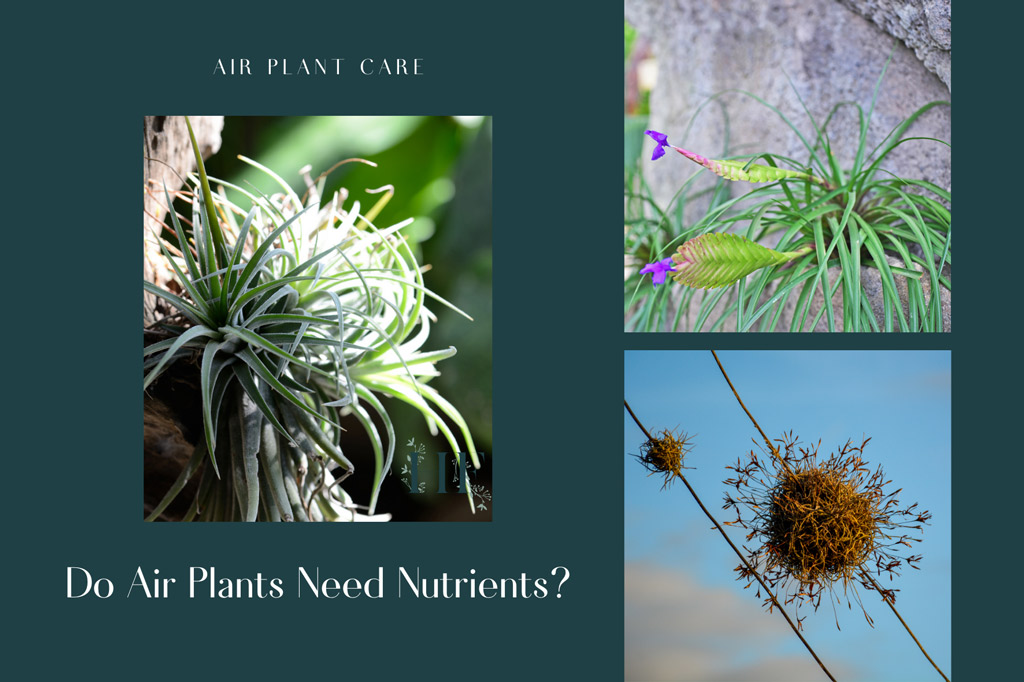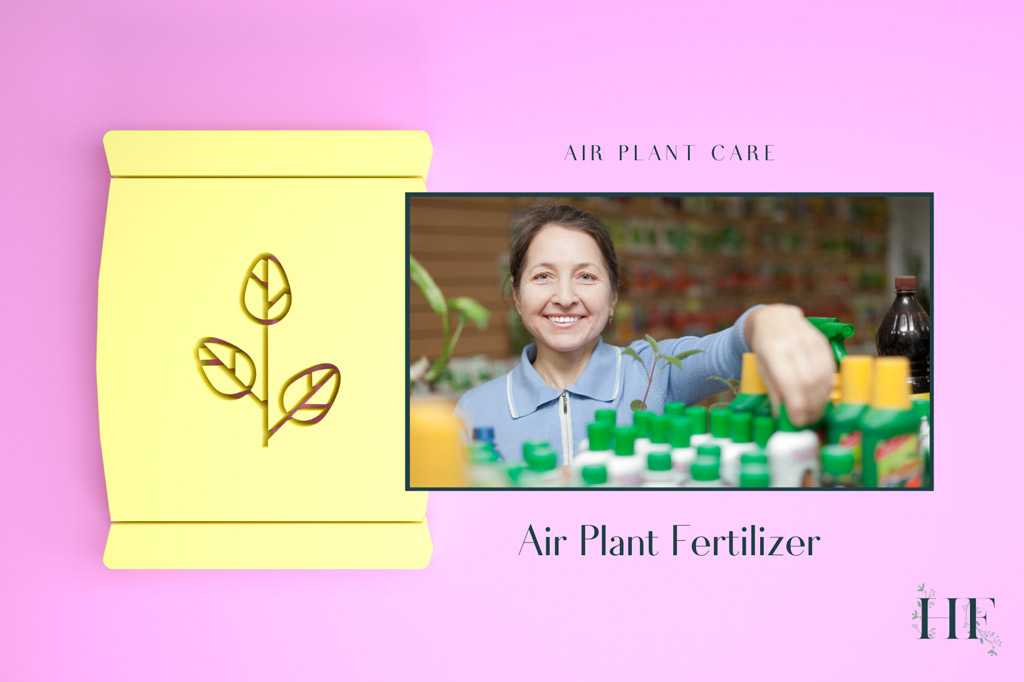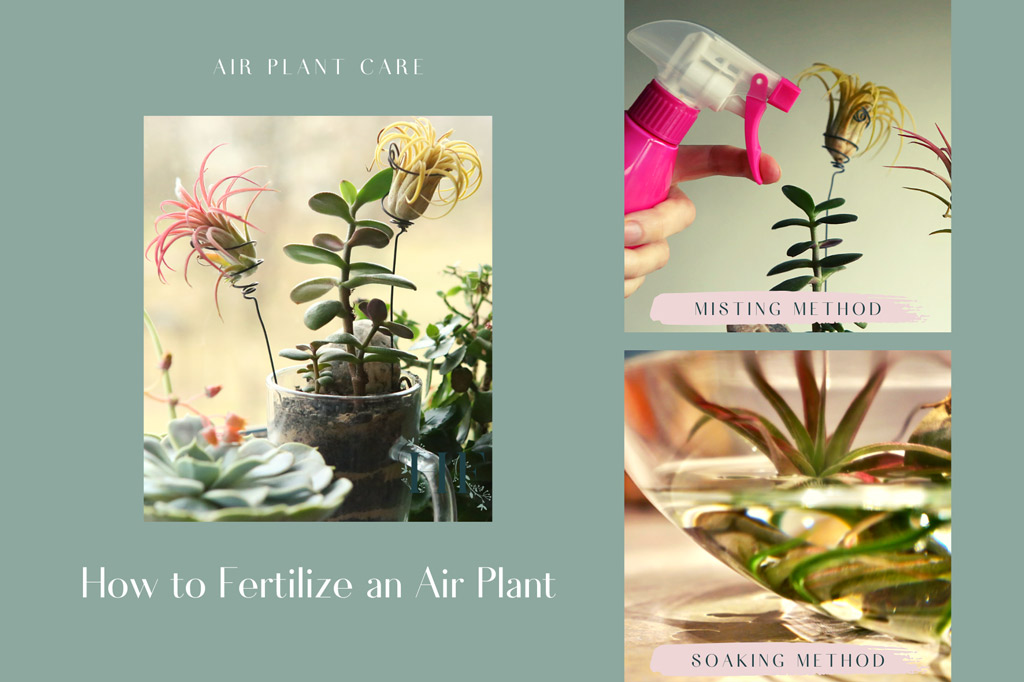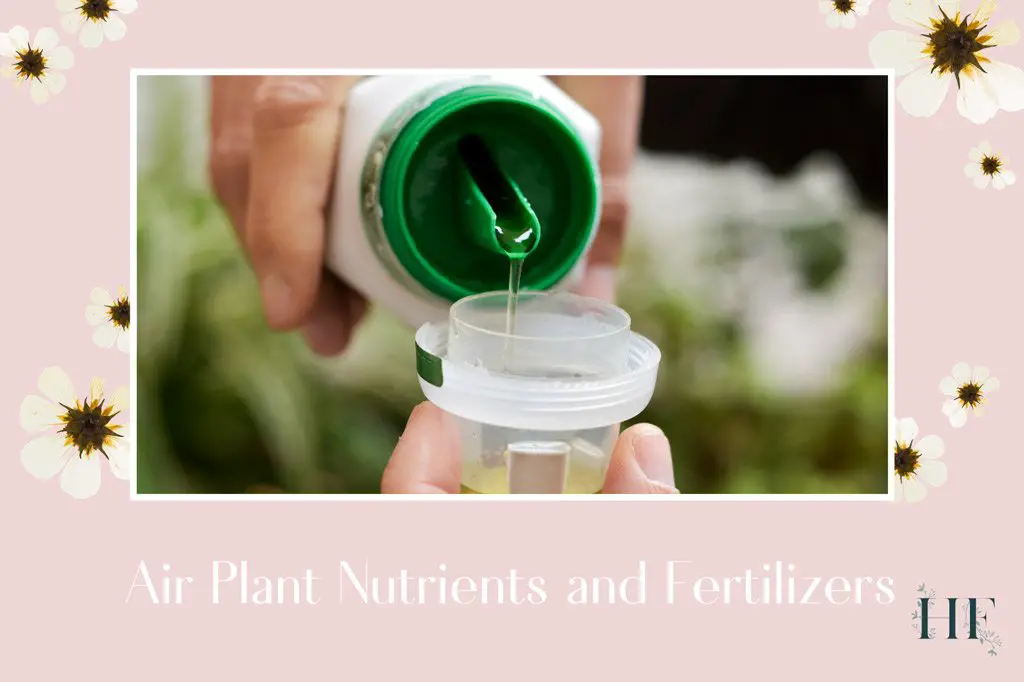As part of taking care of your plants and keeping them healthy, nutrition is a factor to take into account.
But, what do air plants need nutrients for?
Air plants need nutrients to live (minerals like nitrogen, phosphorous, and potassium). In their natural habitat, they use the trichomes in their leaves to get nutrients from rainwater and sunlight.
And do you need to fertilise Tillandsias?
It’s not necessary to fertilise air plants. However, as houseplants, they might need extra nutrients to thrive like they do in the wild. Fertilisers encourage air plant growth, bloom cycle, and offset (pup) production.
Continue reading to find out everything you need to know about the nutritional needs of your air plants.
Air Plant Nutrients
There are 3 factors for healthy reproducing air plants: water, light and nutrients.
Air plants don’t absorb nutrients from the soil, like other plants. These epiphytes use trichomes (little scales on their leaves) to get all the nutrients from the air (including moisture, i.e., water).
When looked at from a microscope, air plant trichomes look like little cups or vessels that open and close to absorb and retain moisture.
Some air plants are “fuzzier” than others, and this is all due to the number of trichomes they have.
Air plants with fuzzy leaves and a silvery or dusty surface are xeric types. These have adapted to have more trichomes in response to dry climates and environmental conditions.
Mesic air plants, on the other hand, have smooth green leaves with less visible trichomes, which is more suitable for South American rainforests.
Air plants convert substances like sunlight, water, C02 and minerals into energy. This process is called photosynthesis.
Tillandsias use this energy to create new leaves and sustain their health. However, extra energy is needed for a plant to either bloom or reproduce. In nurseries or in your home, this process can be enhanced with a fertiliser.

Do Air Plants Need Nutrients?
Yes, air plants need the nutrients they obtain from the sunlight and rain to live.
If you provide your air plants with access to sunlight and water, then they are likely to receive most of the nutrients they need.
However, tap water or any type of purified water don’t have the nutrients that rainwater has.

Air Plant Fertiliser
Although it is not necessary to fertilise air plants, it does help them thrive and encourages growth, bloom cycle, and offset (pup) production.
Most houseplant and garden plant fertilisers consist of a ratio of Nitrogen (N), Phosphorus (P), and Potassium (K). This is represented on the label as “N-P-K,” followed by the percentage or ratio of each mineral.
But, most fertilisers on the market are made for soil-bound plants, therefore, they are not suitable for air plants.
Here’s what you need to know about fertilisers for air plants:
Fertiliser Components for Air Plants
A fertiliser for air plants needs to be different from regular fertilisers because air plants cannot rely on soil to break down nitrogen.
What Minerals Do Air Plants Need?
Air plants need nutrients like potassium, nitrogen, and phosphorous – similar to other houseplants.
- Nitrogen (N): This mineral is responsible mainly for greening and the overall shoot growth of the plant, i.e., the non-flowering reproductive growth or “vegetative growth.”
- Phosphorus (P): It is responsible for root formation, flowering, and setting seeds.
- Potassium (K): This nutrient is important for the plant’s cellular function and regulation (source).
Regular fertilisers have these minerals, just not in the ideal ratio for air plants.
So, what do you need to look for in a fertiliser?
Low-nitrogen fertilisers are best for air plants because it encourages blooming and offset production instead of foliage.
Soil Plant Fertilisers and What to Avoid For Air Plants
Most soil-plant fertilisers contain added minerals and micronutrients that have been formulated for the purposes of vegetation, nutrient deficiency and other reasons that are not directly appropriate for air plants.
Some commonly added minerals to soil-plant fertilisers are:
- Urea: It is a common source of nitrogen release; it has the highest nitrogen content of all solid fertilisers (source). Urea requires urease, an enzyme present in many “soil” bacteria, to transform into the usable form(s) of nitrogen for plants. Air plants are not soil-based, so this transformation doesn’t take place, which can be toxic. This is why Air plant specific fertilisers have the readily absorbable nitrogen form: ammonium or/and nitrate, not urea.
- Copper: It is an essential element and mineral that serves many purposes in plants, but only in trace (small) amounts; it becomes toxic in excess amounts and can kill your air plant. Especially that Bromeliads and Tillandsias are often displayed in arrangements made with copper wires, the copper exposure of the air plant may already be in excess.
- Zinc: Another essential plant micronutrient that can be harmful in excess. Zinc occurs naturally (in small amounts) in air and water; zinc deficiency is most commonly seen in alkaline and sandy soil (source).
- Boron: Boron is also a micronutrient that plays an important role in plants’ growth and development, especially for reproduction: pollination, fruit and seed development (source). It is easy for Boron toxicity to occur (only very small quantities are required as a supplement, and it’s easy to overapply), so for your air plant, it’s best to go with a boron-free fertiliser.
Except for urea which has a clear reason to avoid it, the other minerals should probably be avoided as a matter of caution.
Copper, zinc, or boron toxicity in air plants is hard to detect and can also be complicated to treat. Although the deficiency is possible, it isn’t common.
Because Bromeliads and Tillandsias (indoor air plants especially) live in various environments and arrangements, the best approach is to go for an air plant-specific fertiliser.

What Is the Best Fertiliser for Air Plants?
When choosing a fertiliser for air plants:
- Use a water-soluble fertiliser.
- Avoid copper, boron, and zinc micronutrients.
- Choose a non-urea-based fertiliser. Nitrogen should be in the form of ammonium or nitrate.
- Go for a low-nitrogen ratio.
The best option is to go for a Bromeliad, Tillandsia or epiphyte-specific fertiliser. Here’s an air plan specific fertiliser that you might want to consider.
Can I Use Orchid Fertiliser on Air Plants?
You can use an orchid fertiliser on air plants as long as there’s no urea. You also want to avoid copper, boron, or zinc in the fertiliser as they can cause toxicity and kill your air plant.
When and How Often to Fertilise Air Plants
It’s not advisable to feed your air plants every time you soak or mist them.
Fertilise air plants once a month, especially when blooming. If you notice your plant starting to bloom, this is a good time to fertilise since it will help with flowering, pup production and seed formation.
It’s very important not to overdo it. Air plants can be sensitive to fertilisers, that’s why some plant lovers avoid feeding their Tillandsias.
Appropriate fertilisers might even still be too strong for your air plants. That’s why I start with diluting the fertiliser to 1/4 of the strength recommended on the label and take further steps depending on how the air plant responds.
If you fertilise your air plants too often, the nitrogen in the fertiliser will burn on their leaves and will kill them.

How to Fertilise an Air Plant
When fertilising air plants you can:
- Apply fertiliser during the growing season and when blooming.
- Fertilise only once a month.
- Start by diluting to 1/4 of the strength recommended on the label into lukewarm water.
There are two methods to fertilise air plants:
- Soaking or dunking method.
- Misting or spraying method.
And here’s how it’s done!
Soaking Method
How to fertilise air plants by soaking:
- If you prefer watering your air plants by soaking them, then dissolve the liquid air plant fertiliser directly in the soaking water. Either follow the instructions on the packaging or reduce the strength to 1/4.
- You can fertilise all your Tillandsias in one go or do this one by one. You can reuse the fertilised water in the bowl to fertilise all your air plants on the same day.
- Shake off the excess water.
- Let your air plant dry.
Insider Tip: If your air plant looks very dry, soak it first. Then, you can fertilise it the following day. There’s no point fertilising a plant when what it needs in the first place is water.
Also, keep the flower dry when watering and fertilising. This way you can lengthen the life of the air plant bloom.
Read also: Air Plant Watering Guide – How to Water and Mist Tillandsias.
Misting Method
How to fertilise air plants by misting:
- Dilute the fertiliser to 1/4 of the strength recommended on the label and add it to the lukewarm water that it’s in a glass mister (which doesn’t degrade its contents) or spray bottle.
- Mist your plants, avoiding the bloom.
- Spray until the fertilised water runs down from the leaves.
- Let your air plant dry like you usually do when you water.
Insider Tip: Fertilising your air plant doesn’t replace regular waterings.
Read also: Air Plant Care – 8 Steps to Grow and Keep Tillandsias Alive.

